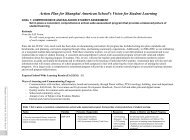••Empowered to interact with the world around them (consistent with theNSSE results);Ethical human beings who demonstration citizenship <strong>and</strong> generositythrough authentic community service <strong>and</strong> actions.The SEARCH Assets data was gathered in 2006, prior to the adoption <strong>and</strong> focus onthe EAGLES. Examples include a continually exp<strong>and</strong>ing <strong>and</strong> vibrant communityservice program that invites all students to participate) for more detail on communityservice at <strong>SAS</strong>, see the Support of Student Personal <strong>and</strong> Academic Growth sectionof this report). Continuing to track the data should give an indication of the progresstoward the integration of the school-wide learning results.Because our EAGLES are difficult to measure through quantitative means alone,in March 2008 the school conducted a Data in a Day exercise to gather baselinequalitative data about the progress we are making with imbedding the EAGLESin our day to day learning (See the Data in a Day Report in the Appendix). Teamsof parents, teachers <strong>and</strong> students on each campus observed a representative schoolday to create a snapshot of each of the EAGLES in action. Areas of strength theyobserved were the following:• Global-minded – in particular, “the <strong>SAS</strong> community engages responsiblyin the world’s problems.” Students <strong>and</strong> staff demonstrate a high level ofinvolvement in clubs <strong>and</strong> activities which demonstrate global-mindedness,e.g., Habitat for Humanity, Model United Nations, Bob the Builder, Roots<strong>and</strong> Shoots, Art for Arts, community service programs. Class materials <strong>and</strong>lessons show an awareness of international environmental issues, history <strong>and</strong>future planning.• Literate – “The <strong>SAS</strong> community communicates articulately throughreading, writing, speaking, listening <strong>and</strong> artistic expression.” A sampling ofevidence observed includes extensive visual arts displays from all divisionsat both campuses, student podcasts <strong>and</strong> participation in forums, blogs <strong>and</strong>wikis at the school Moodle site, student publications: the Pudong Word <strong>and</strong>Puxi Voice, The Puxi middle school grade eight Great Debates <strong>and</strong> middleschool Shakespeare Cup as well as the Pudong rehearsals for the productionof Grease. Student projects <strong>and</strong> posters on visiting authors posted at bothelementary schools, <strong>and</strong> students in classes reading listening, discussing.Observers also found parents engaged in learning through discussions withDr. Michael Thompson on supporting their children in school.• Skilled Inquirers – “The <strong>SAS</strong> community strives for academic excellence.”Students <strong>and</strong> teachers have high expectations which are supported by excellentresources <strong>and</strong> a high st<strong>and</strong>ard of care. Evidence details the level of supportprovided through student volunteers, mentors, peer feedback, individualconferencing, teacher collaboration <strong>and</strong> after school help for <strong>SAS</strong> students.Areas that the Data in a Day observers identified for further investigation includedthe EAGLE, “ethical human beings.” At that time, observers reported limitedevidence illustrating underst<strong>and</strong>ing of the outside world <strong>and</strong> the issues affecting othercultures <strong>and</strong> communities. In the time since, all divisions have been very involvedwith <strong>SAS</strong> Responds, disaster relief for victims of both the Myanmar typhoon <strong>and</strong> theSichuan Province earthquake. Teachers, students, parents, <strong>and</strong> administration raisedUS$79, 633 in relief funds. The issues have been discussed in classes, in clubs, onemail, <strong>and</strong> in their families, powerfully demonstrating citizenship <strong>and</strong> generositythrough this community service activity.The second descriptor for “ethical human beings” is more difficult. Intervieweesraised the issue of theft to Data in a Day observers. Follow-up research found thattheft has been reported at all divisions <strong>and</strong> is an area of concern that the school needsto take a careful look at.86Shanghai American School Self Study Report
Finally, the question of academic honesty has been raised by students <strong>and</strong> teachers.Measures are in place to encourage academic honesty, including the use of turnitin.com, a web-based plagiarism site to which student submit their written work. Thereis also a set of consequences outlined in student h<strong>and</strong>books. The issue remains,however, <strong>and</strong> is an area for continued follow-up as we look at teaching <strong>and</strong> assessingthe <strong>SAS</strong> EAGLES.While some decisions about what baseline data to gather to measure our progresstoward achieveing the EAGLES, further refinement is called for. Continued analysisof both qualitative <strong>and</strong> quantitative evidence will be necessary to track <strong>SAS</strong>’sprogress in this area.Assessment School-wideThe school has identified assessment as an important need school-wide, beginningwith developing a school-wide assessment philosophy. A two-year plan to addressthe need, beginning in 2008-2009, is published in the <strong>Curriculum</strong> <strong>and</strong> ProfessionalDevelopment H<strong>and</strong>book.In fact, however, the work on assessments has already begun. In 2007-2008, commonassessment parameters were addressed in language arts <strong>and</strong> Chinese program reviewtask forces. PRC teachers in the Chinese department undertook initial professionaldevelopment in formative <strong>and</strong> authentic assessment <strong>and</strong> how that looks in languageclassrooms. Formative assessment is built into units the group has drafted <strong>and</strong> willpilot in middle <strong>and</strong> high school in 2008-2009.In addition, in summer 2008, the school sent eighteen teachers <strong>and</strong> administratorsto the Assessment Training Institute in Portl<strong>and</strong> to begin the work of establishinga coherent assessment framework across the school, beginning with establishing aschool-wide assessment philosophy. This core group, representing all six divisions<strong>and</strong> administration, will flesh out the plan for the school’s progress on assessment<strong>and</strong> lead the process. The school is on target with its published plan, but needs todevote continued attention to assessment practices school-wide as we move forward.Areas of Strength (tied to <strong>SAS</strong> Vision points)Create programs, assessments <strong>and</strong> experiences that serve to unite the school <strong>and</strong>to celebrate the distinctiveness of each campus community.••••The school consistently shows positive external assessment resultsCollaboration on common assessments within each division is emergingacross the school.In many subject areas teachers use a variety of assessments to gauge studentprogress.Decisions in program review are based on student learning data.Areas for Follow-up (tied to <strong>SAS</strong> Vision points)Create programs, assessments <strong>and</strong> experiences that serve to unite the school <strong>and</strong>to celebrate the distinctiveness of each campus community.• Ensure that all subject areas develop common assessments <strong>and</strong> that commonassessments in place are regularly moderated, refined, <strong>and</strong> used to instructcurriculum delivery.• Provide consistency across the school in the assessment protocols <strong>and</strong>practices governing common assessments, <strong>and</strong> the variety <strong>and</strong> range ofShanghai American School Self Study Report 87



